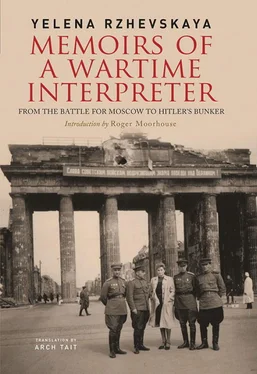‘Hitler kaput !’ they said to us by way of a farewell greeting.
He certainly was. No two ways about that.
Once More, Ampoule Fragments
The newspapers of the Allied occupation troops had already come out with a resounding headline: ‘Russians Find Hitler’s Body’.
Among our troops something ridiculous was going on. People were suddenly being urged to ‘Hunt for Hitler’. This was a deceitful charade, a weird attempt to disguise the fact that his body had been found, a pretend search.
A declaration signed by Stalin, Roosevelt and Churchill had stated that the Allies undertook to seek out the Nazi leaders wherever they might be hiding and make them face an international court. And here the senior Nazi leader of the lot of them was, right here in Berlin, no distance at all from the Allied Control Council. So why not show them his body? Bring to it eyewitnesses of Hitler’s death, both from our and their sides, and identify it? Make a joint statement and close the matter?
On 8 May, however, just as a forensic medical examination of Hitler’s remains was taking place in Buch, on the northeastern outskirts of Berlin, another report appeared in the Moscow newspapers claiming that he might have landed in Argentina, or was possibly hiding with Franco in Spain. The evidence was being concealed and when, eventually, people would want to dig down and get the real facts, it would be too late: the witnesses would have dispersed or died, and even the testimony of those still alive would be unconvincing after so much time had elapsed.
Our view was that, if not at the present time, then at some point in an unclear future this conspiracy of silence would come to an end. It was bound to, so facts needed to be established now that would be unchallengeable even then. Already some of our superiors, detecting currents coming down from ‘above’, were looking askance at our zeal, keeping us at a distance because of their instinct of self-preservation (and perhaps something of the sort was true of Zhukov).
Quite a few people had been involved in the search and the first stage of the investigation. Now, as the secretiveness increased, almost all of them were taken out of the loop, and by the second stage, actual identification of the remains, Colonel Gorbushin’s group had dwindled to just three people, including me as the interpreter.
The people doing their best to establish the truth about Hitler went about their business with a sense of heavy responsibility. They believed that the least lack of clarity about what had happened would be dangerous: it would breed legends that could only contribute to a rebirth of Nazism. Giving an unambiguous answer to the question of whether or not Hitler was alive was important also for the future of Germany.
Colonel Gorbushin decided in these difficult circumstances to obtain indisputable evidence. We were stationed in Buch, and whether in a modest house or a shed I found it difficult to say with any certainty until I later revisited the place. Sure enough, it was a small house. The remains of Goebbels, his wife and children were removed to its cellar.
Here, too, to Buch, on the orders of Colonel Gorbushin, were brought the remains of Adolf Hitler and Eva Braun.
This was a street of small, modest detached houses with a great vault of sky overhead. Young children were pedalling around furiously on their bicycles; the adults walked by, engrossed in their worries and cares, unaware of, and showing no curiosity about, what was now located here.
I was confident that within another day or two the whole world would know we had found Hitler’s body. If I had known then that years later I would testify about all this in detail, I would probably have overcome my squeamishness and taken a closer look at those crudely constructed crates with their hideous, blackened remains – I had already seen them in the grounds of the Reich Chancellery – but I did not do so.
Here in Buch, when Hitler came to power, on his orders, people were subjected in the old, reputable clinics to ‘racial evaluation’ for the first time. In 1936 a card index of ‘hereditary biological health’ was introduced here, encompassing all residents of the large Berlin district of Pankow. A person’s fate, his career, the right to marry, the right to life itself, all depended on what was on his index card.
And as chance would have it, this was where Hitler himself was now brought to be subjected to forensic medical examination. On 3 May, following the discovery of the bodies of Goebbels and his family, a commission of army doctors appointed by order of Lieutenant General Telegin of the Military Council of the 1st Byelorussian Front, got to work in a brick building at the clinic in which Surgical Mobile Field Hospital No. 4961 was currently housed.
Now, without needing to inform Telegin, a couple more corpses were tossed the commission’s way, rather like cuckoos’ eggs. The commission included eminent forensic medicine specialists and pathologists: the chief pathologist of the Red Army, Lieutenant Colonel Kraevsky; Doctors Marants, Boguslavsky and Gulkevich. The man in charge was Medical Service Lieutenant Colonel Faust Shkaravsky, principal forensic medicine specialist of the 1st Byelorussian Front.
There was something portentous about Adolf Hitler being dissected under the watchful eye of Dr Faust. The autopsy was performed by a female doctor, Major Anna Marants, acting principal pathologist of the 1st Byelorussian Front, and it took place in Berlin-Buch on 8 May 1945.
Here is how Hitler appeared at the autopsy, as described in the official report:
The remains of the charred body of a male were delivered in a wooden crate 163 cm long, 55 cm wide and 53 cm high. A piece of knitted cloth measuring 25 × 8 cm, of a yellow colour, charred at the edges, resembling a knitted vest, was found on the body.
Given that the body has been burnt, it is difficult to judge the age, but it can be assumed that this was 50–60 years, the height is 165 cm (not an exact measurement owing to charring of tissue)… The body is significantly charred, exuding the odour of burnt flesh…
There are no visible signs of severe, lethal injuries or diseases on the body, which has been significantly affected by fire…
In the mouth, glass splinters were found which are parts of the walls and base of a thin-walled ampoule.
After a detailed examination, the commission concluded,
Cause of death was poisoning with cyanide compounds…
A test tube containing ampoule fragments found in the mouth of the corpse is attached to this certificate.
No other signs of harm that could result in death were established. Western researchers, journalists and memoirists frequently insist that Hitler shot himself: some from simple ignorance because of all the inaccurate information circulating about Hitler’s death, others from a desire to embellish the circumstances of his end. It was a German Army tradition that a commander, if he committed suicide, should use a pistol. It is instructive, however, that General Krebs, who ‘had the army in his bones’, preferred to take poison as the more reliable method.
To us the manner in which Hitler committed suicide was immaterial, and neither were we versed in the traditions of the German Army: they were of no interest to us. The fact remains that Dr Faust Shkaravsky and his competent colleagues carried out at that time a thorough medical examination and concluded that Hitler had taken poison.
Günsche, standing outside the door, did not hear a shot but did notice a strong smell of bitter almonds when the door was slightly open. Some people, Hitler’s secretary Gertraud Junge, for example, did hear a shot. She said, ‘When I left Hitler’s office and went up the stairs to the shelter landing, I heard two shots. I imagine the shots were fired in Hitler’s office.’
Читать дальше











